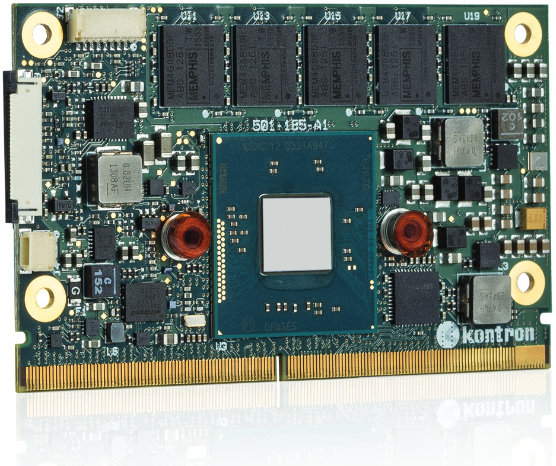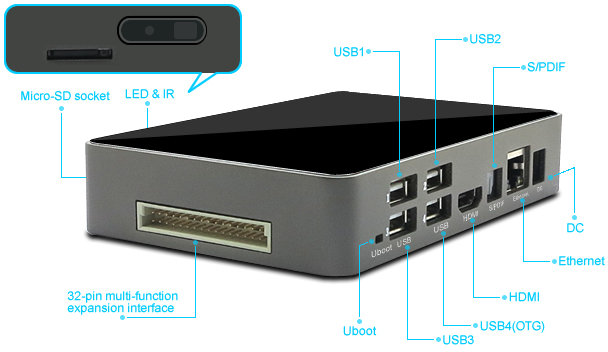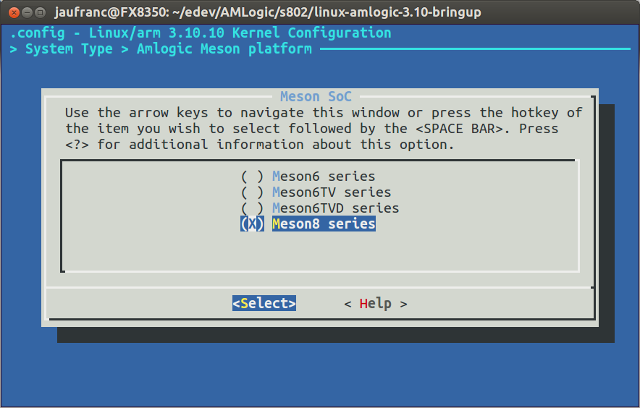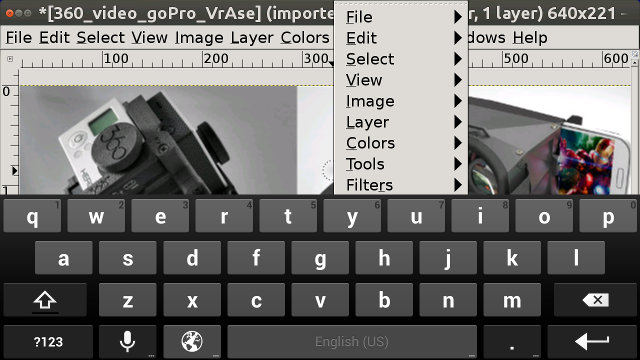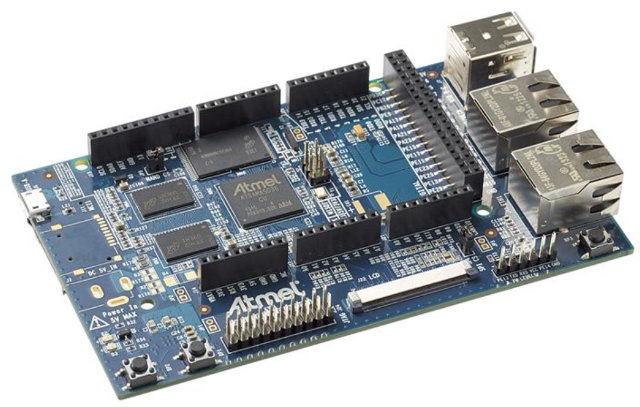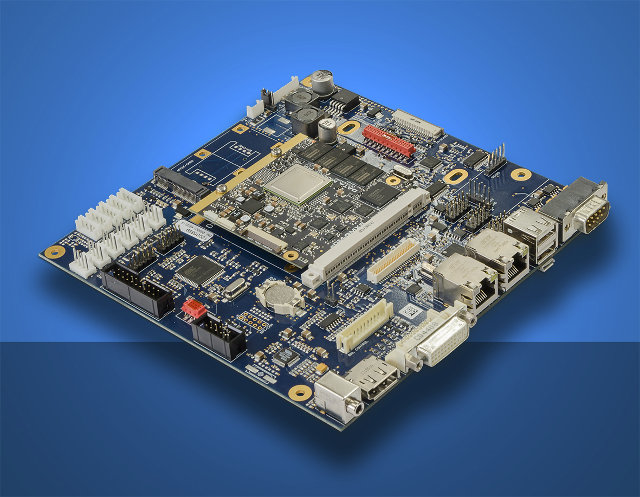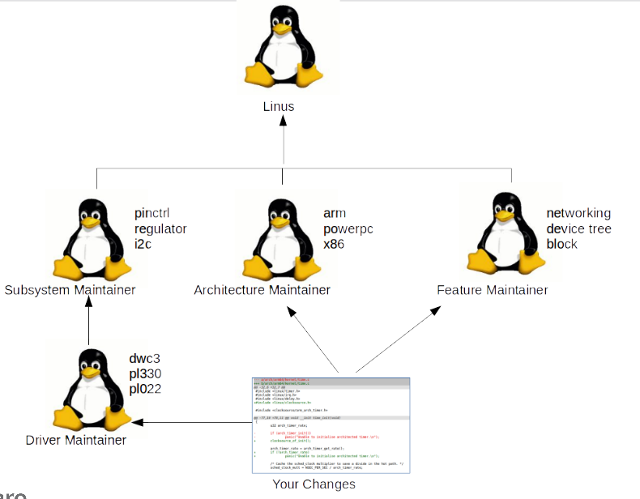Kontrol has unveiled a computers-on-module based on the SMARC standard, previously ULP-COM, based on Intel Atom E3800 “Bay Trail-I” SoCs with up to 8GB LPDD3 memory, up to 64GB SSD, and support for various interface. After having released SMARC modules based on TI, Freescale and Nvidia last year, the company claims their SMARC-xXBTi is the first ever x86 CoM compatible with SMARC. SMARC-sXBT(i) specifications: SoC – Intel Atom E3800 “Bay Trail-I” with Intel Gen 7 Graphics System Memory – Up to 8GB DDR3L-1067/1333 (1.35V) with optional ECC Storage – 2-32 GB eMMC (SLC), 4-64GB for (MLC), 1x or 2x SATA 3Gb/s, 2x SDIO interfaces Display HDMI 1.4 up to 2560 x 1600 @ 60Hz 18/24-bit single channel LVDS up to 1366 x 768 (Optional eDP to have higher resolutions) Connectivity – Gigabit Ethernet (Intel Springville I210) USB – 1x USB 3.0 (via AFB), 2x USB 2.0, and optional USB OTG. […]
Dedicated Hosting Services on ARM Development Boards (Cubieboard2, Raspberry Pi, ODROID…)
At least two companies have recently launched hosting services using dedicated ARM servers based on low cost development boards: NanoXion with its NX-BOX service powered by PiBox (Raspberry Pi) and CubieBox (Cubieboard 2) microservers, and miniNodes with servers based on Cubieboard2 first, then ODROID development boards, and possibly AllWinner OptimusBoard once/if it becomes available. The PiBox will feature a Raspberry Pi Model B with 512 MB RAM, and 16GB Class 10 UHS-1 microSD card by Samsung, and the dual core Cubiebox comes with 1GB RAM and a Crucial M500 SATA III 120GB SSD. Both NX-BOXes run Linux Debian Server NX distribution, support instant remote reboot, with guaranteed 10 Mbps connectivity for IPv4 & IPv6, and unlimited bandwidth. The boards are all hosted in France. The company expects their ARM servers to be used as private cloud servers, backup servers, private chat servers, web servers, mail servers, DNS Servers, monitoring servers, and […]
ITEAD Studio IBOX Powered by AllWinner A20 Features a 32-Pin Hacker-Friendly Connector (Crowdfunding)
ITEAD Studio IBOX is a mini computer powered by AllWinner A20 dual core Cortex A7 processor with 1GB RAM and 4GB Flash, a few USB connectors, Ethernet and video/audio connector. This mini pc can run both Android & Linux, and features a 32-pin connector that allows to connect expansion boards. Let’s have a look at the specifications: SoC- AllWinner A20 dual core ARM Cortex-A7 @ 1 GHz + ARM Mali 400 MP2 System Memory – 1GB DDR3 RAM Storage – 4GB NAND Flash + microsd slot Video Output – HDMI Audio Output – HDMI, optical S/PDIF Connectivity – 10/100M Ethernet USB – 3x USB 2.0 host port, 1x USB OTG port (full size) Expansion – 32-pin proprietary connector with TV OUT, USB, LCD, UART, IR, CSI, SPI, SATA, GPIOS and power signals. Misc – LED , IR sensor, and U-boot button (FEL mode?) Power – 5V/2A 9V/2A Dimensions – 145 x […]
Amlogic GPL Source Code Release – Kernel 3.10, U-Boot, and Drivers (Wi-Fi, NAND, TVIN, Mali GPU)
Last month, I noticed Amlogic provided links to the Android SDK for S802 / M802 on their open source website, but the only way to get the source was to share your SSH public with Amlogic, so that they give you access. It did not happen, but the company has released the source for Linux 3.10.10, U-boot 2011.03, Realtek and Broadcom Wi-Fi drivers, NAND drivers, “TVIN”drivers, and kernel space GPU drivers for Mali-400 / 450 GPU. There are also some customer board files for Meson 6 only (AML8726-MX / M6) but they do not seem to match the kernel… If you want to build the kernel, including the drivers, you’ll need to download a bunch of files: wget http://openlinux.amlogic.com:8000/download/ARM/kernel/arm-src-kernel-2014-03-06-d5d0557b2b.tar.gz wget http://openlinux.amlogic.com:8000/download/ARM/wifi/rtk8192du-2014-03-06-7f70d95d29.tar.gz wget http://openlinux.amlogic.com:8000/download/ARM/wifi/rtk8192eu-2014-03-06-9766866350.tar.gz wget http://openlinux.amlogic.com:8000/download/ARM/wifi/rtk8192cu-2014-03-06-54bde7d73d.tar.gz wget http://openlinux.amlogic.com:8000/download/ARM/wifi/rtk8188eu-2014-03-06-2462231f02.tar.gz wget http://openlinux.amlogic.com:8000/download/ARM/wifi/brcmap6xxx-2014-03-06-302aca1a31.tar.gz wget http://openlinux.amlogic.com:8000/download/ARM/wifi/wifi-fw-2014-03-06-d3b2263640.tar.gz wget http://openlinux.amlogic.com:8000/download/ARM/modules/aml_tvin-2014-03-06-fb3ba6b1c8.tar.gz wget http://openlinux.amlogic.com:8000/download/ARM/modules/aml_nand-2014-03-06-39095c4296.tar.gz wget http://openlinux.amlogic.com:8000/download/ARM/customer/aml_customer-2014-03-06-76ce689191.tar.gz wget http://openlinux.amlogic.com:8000/download/ARM/gpu/gpu-2014-03-06-0425a1f681.tar.gz You’ll need to extract these tarballs in specific directories:
|
1 2 3 4 5 6 7 8 9 10 11 12 13 14 15 16 17 18 19 20 21 22 23 24 25 26 |
tar xvf arm-src-kernel-2014-03-06-d5d0557b2b.tar.gz mkdir -p hardware/amlogic/ mkdir -p hardware/wifi/realtek/drivers mkdir -p hardware/wifi/broadcom/drivers mkdir -p hardware/arm/ cd hardware/amlogic tar xvf ../../../aml_nand-2014-03-06-39095c4296.tar.gz mv aml_nand-amlogic-nand nand cd ../wifi/realtek/drivers tar xvf ../../../../rtk8192du-2014-03-06-7f70d95d29.tar.gz tar xvf ../../../../rtk8192eu-2014-03-06-9766866350.tar.gz tar xvf ../../../../rtk8192cu-2014-03-06-54bde7d73d.tar.gz tar xvf ../../../../rtk8188eu-2014-03-06-2462231f02.tar.gz mv rtk8188eu-8188eu 8188eu mv rtk8192du-8192du 8192du mv rtk8192cu-8192cu 8192cu mv rtk8192eu-8192eu 8192eu cd ../../broadcom/drivers tar xvf ../../../../brcmap6xxx-2014-03-06-302aca1a31.tar.gz mv brcmap6xxx-ap6xxx ap6xxx cd ../../../arm tar xvf ../../gpu-2014-03-06-0425a1f681.tar.gz mv gpu-r3p2-01rel3 gpu cd .. tar xvf ../../aml_tvin-2014-03-06-fb3ba6b1c8.tar.gz mv aml_tvin-amlogic-3.10-bringup tvin |
You […]
Xserver XSDL X Window Server for Android Allows You to Run Linux Apps in Android
It has been feasible to run Linux apps in Android by installing a Linux distribution in a chroot using some app such as Complete Linux Installer, and accessing the graphical application via VNC. I tested this solution with Ubuntu in Android using ODROID-X development board, and it worked fine, except the performance was rather poor. There’s now another solution with XServer XSDL app, X Window System server for Android, that can be used to stream application from a Linux PC or to launch app from a Linux distribution installed in your Android device. I’ve given a quick try in my Android phone, and after installing and running the app, it will give instructions to launch gimp in your Linux PC to use it in the phone: Launch these commands on your Linux PC env DISPLAY=192.168.0.100:0 metacity & env DISPLAY=192.168.0.100:0 gimp Just type this command line into a terminal, and gimp […]
$79 Atmel ATSAMA5D3 Xplained Arduino Compatible, Open Source Hardware Board Powered by SAMA5D3 ARM Cortex-A5 Processor
A few days ago, at Embedded World 2014, Atmel has unveiled ATSAMA5D3 Xplained evaluation board based on SAMA5D36 ARM Cortex A5 micro-processor with 256 MB DDR2, 256 MB flash and numerous ports and expansion connectors, that targets industrial automation, networks, robotics, control panels and wearable applications. Atmel is one of the rare companies that provides support for the latest long term kernel (3.10) and mainline for their embedded solutions, and their latest board is fully open source hardware. Let’s have a look at the board specifications: MPU – Atmel SAMA5D36 Cortex-A5 Microprocessor @ 536 MHz System Memory – 2GBit DDR2 (Micron) Storage – 2GBit Flash (Micron), SD/MMCPlus 8-bit Card slot, 1x Micro SD Card 4-bit slot footprint (meaning not soldered) Connectivity – 1x Ethernet 10/100/1000M, 1x Ethernet 10/100M USB – 1x micro USB Device connector, 2x USB Host connectors Debugging – 1x 6-lead 3V3-level serial port, 10-pin J-TAG connector Expansion […]
DATA MODUL mini-ITX Board Supports Freescale i.MX6 & Intel Bay Trail-I QSeven Modules
DATA MODUL, a specialist supplier of display technology, has recently unveiled eDM-mITX-CB-Q7-Info, a mini-ITX Baseboard for ARM & x86 Qseven modules optimized to drive large panels for digital signage applications. In theory, the board should support any Qseven modules, but for now only Data Modul’s Freescale i.MX6, and Congatec conga-QA3 Intel Atom E3800 series modules have been optimized and officially certified to work with the motherboard. Precisely, the board is optimized and certified for the following modules: DATA MODUL ARM Qseven SoMs: eDM-QMX6 (i.MX6Quad) eDM-DMX6 (i.MX6Dual) eDM-DLMX6 (i.MX6Dual lite) Congatec x86 Qseven SoMs: Conga-QA3 with Atom E3845 (Quad core) Conga-QA3 with Atom E382x (Dual core). Three models: Atom E3827, E3826 or E3825. Conga-QA3 with Atom E3815 (Single core) You may have heard about EDM, a competing module standard, previously, but the eDM prefix in the ARM modules or the mini-ITX board names has nothing to do with this standard, as […]
Linux Kernel Upstreaming How-To – Linaro Connect Asia 2014
I’ve already written a post about submitting kernel patches to mainline based on a 2011 presentation by Greg Kroah-Hartman, but Matt Porter, Broadcom Landing Team (LT) Technical Lead at Linaro, has given two updated talks entitled “Upstreaming 101” and “Upstreaming 201” at Linaro Connect Asia 2014. There are many planned talked during LCA 2014, and you can get the list as well as links to presentation and videos, as they become available on LCA 14 resources page. The first session “Upstream 101” starts with some definitions such as “upstreaming” (basically getting your code to kernel.org), “mainline”, etc, explains how to get information about the (912) maintainers (tip: it’s in the MAINTAINERS file), how to deal with the 2-week merge windows occurring every 10 weeks or so, but the bulk of the talk detailing the work flow required to upstream code to the Linux kernel. There are basically 5 steps: Preparation – Read […]


